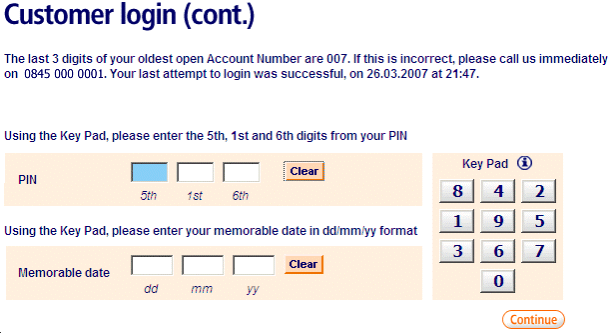A few weeks back, I read a column in the IT trade press about my bank’s botched attempt to upgrade their website security and I realised that it’s not just me who thinks banks have got it all wrong…
You see, the banks are caught in a dilemma between providing convenient access for their customers and keeping it secure. That sounds reasonable enough until you consider that most casual Internet users are not too hot on security and so the banks have to dumb it down a bit.
Frankly, it amazes me that information like my mother’s maiden name, my date of birth, and the town where I was born are used for “security” – they are all publicly available details and if someone wanted to spoof my identity it would be pretty easy to get hold of them all!
But my bank is not alone in overdressing their (rather basic) security – one of their competitors recently “made some enhancements to [their] login process, ensuring [my] money is even safer”, resulting in what I can only describe as an unmitigated user experience nightmare.
First I have to remember a customer number (which can at least be stored in a cookie – not advisable on a shared-user PC) and, bizarrely, my last name (in case the customer number doesn’t uniquely identify me?). After supplying those details correctly, I’m presented with a screen similar to the one shown below:

So what’s wrong with that? Well, for starters, I haven’t a clue what the last three digits of my oldest open account are so that anti-phishing question doesn’t work. Then, to avoid keystroke loggers, I have to click on the key pad buttons to enter the PIN and memorable date. That would be fair enough except that they are not in a logical order and they move around at every attempt to log in. This is more like an IQ test than a security screen (although the bank describes it as “simple”)!
I could continue with the anecdotal user experience disasters but I think I’ve probably got my point across by now. Paradoxically, the answer is quite simple and in daily use by many commercial organisations. Whilst banks are sticking with single factor (something you know) login credentials for their customers, companies often use multiple factor authentication for secure remote access by employees. I have a login ID and a token which generates a seemingly random (actually highly mathematical) 6 digit number that I combine with a PIN to access my company network. It’s easy and all it needs is knowledge of the website URL, my login ID and PIN (things that I know), together with physical access to my security token (something I have). For me, those things are easy to remember but for someone else to guess – practically impossible.
I suspect the reason that the banks have stuck with their security theatre is down to cost. So, would someone please remind me, how many billions did the UK high-street banks make in profit last year? And how much money is lost in identity theft every day? A few pounds for a token doesn’t seem too expensive to me. Failing that, why not make card readers a condition of access to online banking and use the Chip and PIN system with our bank cards?
[This post originally appeared on the Seriosoft blog, under the pseudonym Mark James.]